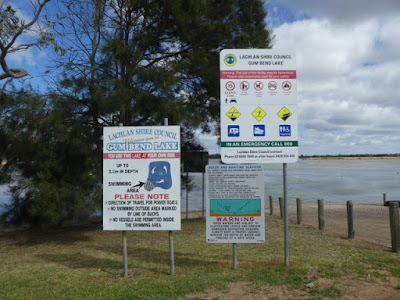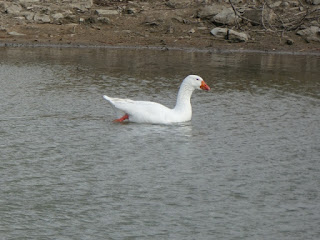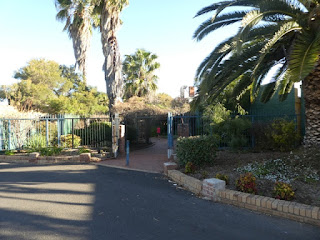'Condo', as it is universally known by the locals and any who have lived in this or nearby areas (like one of our close relatives) is not a large town. About 4,000 souls call it home. The early exploration of the area throws up the name of Thomas Mitchell yet again. The meandering Major came through this area in 1836, the same year as the original settlers were coming ashore at Holdfast Bay to establish our home city of Adelaide.
As happened in so much of Australia, the reports of what Mitchell had found prompted squatters to move into the area, and by 1844 the large 'Condoublin' sheep run had been established.
The discovery of copper nearby in 1885, and gold just north-west of the town in 1896, cemented the town's future, a town in which the population had already begun to increase with the break down of the large sheep runs into smaller holdings. The arrival of the railway line just before the turn of the century assured the town's future.
As we had seen coming into the area, agriculture is now the mainstay of the district, assisted greatly by the construction of the Wyangala dam across the Lachlan River in 1935. Cereal crops, canola, sheep and cattle production have been common in the district for years, and in more recent times expanded irrigation systems have allowed for horticulture and the production of cotton.
The nearby Mount Tilga is oft proclaimed as the geographical centre of New South Wales, although this remains the subject of debate in the scientific community (of course....and, frankly, who cares!)
One interesting local fact which is not in dispute is that the 'Overflow' sheep station lies close to Condobolin. And yes......this is the very place which formed the setting for that most famous of Australian bush poems by Banjo Patterson, 'Clancy Of The Overflow'.
As always, with a day or so up our sleeves, we set off to see what the town, well the main business district at least, had to show for itself.
The sky was clear and the weather thankfully warmish as we set off past the playing fields opposite our caravan park on a mid Sunday afternoon.
This is our favourite time to be wandering around a new town when I, in particular, can rubberneck and snap away with gay abandon without the background noise of the incessant and very wise cautionary cries from my travelling companion as I completely forget about the fact that hard and heavy motor vehicles have more right in the middle of a roadway than I (no matter how important the spot is for that ideal photo!).

and walked past the rather sad looking pepper corn trees we had seen on our way in a day ago (this harsh pruning is apparently an annual event).
We retraced our steps back to the approach to the Lachlan River road bridge
and duly made our way across this relatively narrow, but significant inland waterway.
The descent off the bridge brought us to an intersection
where, on one side we found the town Memorial gardens
and on the other, the grounds of Smythe Park (photographed very poorly in the late afternoon sunlight of our return stroll), an area which pays tribute to a local luminary.

What could be classed as the main intersection in the CBD was now in sight where the now named Williams Street crosses Bathurst.
Well maintained street gardens are a real feature of this spot in central Condobolin.

The prominent white building on the far side of the intersection houses the local Aboriginal art centre. As we wandered about the town we noticed that several of the more prominent buildings were given over to use by the local brothers, something which we had not seen to such a degree elsewhere.

As for Bathurst Street itself, home to the town's main commercial precinct (seen here looking east from Williams), this is decidedly a street of two parts. At this near end all the buildings are dedicated to commercial enterprise and shopping, whilst at the further end, some of the more elegant of Condo's architecture is on show.

Our first and abiding impression of the CBD, and indeed much of the town, is that it just seemed to be somewhat tired.

Several shop proprietors had made some effort to tart things up a tad such as evidenced by these hanging pots, and in spots street gardens did give a lift to the general appearance of things, but for us none of it quite worked.
But that general observation aside, the street does house some more than interesting buildings, and one thing which is well done here is the placement of many informative footpath plaques which provide a potted history of relevant buildings in the town centre. I'll include a selected few as we move along.
As we had found in Gilgandra, red brick has been the building material of choice for most of the larger edifices and there is clear evidence of the use of the 'art deco' style.

The Royal Hotel, which dominates the western end of Bathurst Street, presented a fine example.

And it was here, immediately next door to this large country pub, that we come across the first of Condobolin's main street surprises. This courtyard affair demanded further exploration.

Two brass plaques on the stone entrance post told the story,
and I'll let them speak for themselves.
This was the first inkling I had about the prominence of Cobb and Co in this region. The second of the two plaques is much more personal, and apart from the manner in which it lauds
the commendable efforts of 'Dad' Tasker, I was fascinated to read that this fine hostelry was the first in the country to bathe in electric light, ahead of all the major cities in the country. I suspect that fact says something about the former status of Condobolin, its wealth and its prominence in the rural community of New South Wales.
This really was a fascinating little courtyard, where sadly the obviously deciduous archway creepers were still leafless and drab,
and the rock gardens lay bare and cold in the slanted afternoon sun,
but as we strolled through to the far end of this leafy lane which connects the rear pub car park to the main street, I had no difficulty imagining what a lovely cool oasis this would be in the heat of high summer in central NSW.
Right next to the Royal we came across this plaque which again proffered an insight into Condo's development about which I had previously been unaware.
Our eastward ramble along Bathurst Street soon brought us to the next intersection where,
on one corner of McDonnell Street, the NAB building presented another example of the red brick brigade of buildings
whilst opposite we found the Imperial Hotel constructed in a style which we far more easily associate with these country towns of some original wealth.
East of McDonnell Street the street scape of Bathurst Street changes dramatically with a somber looking row of large, dark buildings standing somewhat starkly sentinel over the wide street.
And what a mixture of uses we found here. The two storey Commonwealth Bank building rubbed shoulders with the fobidding fascade of what is now the Zangne craft and coffee shop.
Squeezed up alongside these the old Fire Station building seemed to almost cower
beside the bulk of old town hall building and the local post office.
Completing this row of grand old buildings we have the Condobolin court house, again featuring red brick and what I could only assume was an attempt to impress all who came here with the importance of the occasion, a row of quite grand white columns supporting the verandah roof.
By now we had reached the point where Bathurst Street intersected with the main road into and out of town and here we found the last of the more impressive buildings, originally the Commercial Hotel,
now used as the Condobolin Community Centre as detailed in yet another of the town's most informative street plaques.
Before making our way back west along Bathurst Street, we did detour briefly up McDonnell, where I was keen to check out the local RSL only to find,
as is common in NSW, that this is not a sub-branch as such but a commercial enterprise......a 'services club' as they are known. But at least there was a 'hole in the wall' office for the stalwarts of the organisation in this large commercial building.
And just for something completely different it was not far from here that we passed one of Condo's cottages, a wooden home of little pretension which was one of many of this ilk which abound in this town.

Here too we came across one of Condobolin's several churches built as they all were from, yep, red brick.

Back in Bathurst Street we found that the buildings of the southern side were far less grand than those opposite, something of a hotchpotch of styles

including one real little sandstone oddity, jammed hard against its blue art deco neighbour. I remain unsure if the firm of solicitors which occupies this building were responsible for its design and construction. If this were the case, and it was intended to portray a sense of solid assurance, it really does miss the boat, but then I guess its incongruity does provide a talking point!

The nearby home to the Aboriginal Health Services was the one prominent building on this side of the street which matched the general style of those opposite.

We soon found ourselves back at the point we had started where the history of the cleverly named 'Miles Ahead' building
was presented on another of the ubiquitous town street plaques.
By now we had just about had enough, but we did take the time to check out what lay to the west of the main intersection.

Here we discovered another tribute to one of Condobolin's favoured sons. This decidedly different 'fountain' commemorates the achievements of one LJ Hunt, the engineer for the Lachlan Shire between 1964 and 1978.

This end of the street is also home to the local library and its delightful surrounding street gardens,

and a fountain of another sort, erected, as we read, to commemorate the fluoridation of the local water supply in 1963. This is something which normally would not have attracted other than our fleeting attention, but this did for one reason........

......it had no tap or any other means by which it could be used. Now that's a real asset for a drinking fountain! Sadly I found that this somewhat representational of much of what we saw in the town...jaded and just not quite up to scratch.
This observation is clearly subjective, and I am sure would be stoutly rejected by the fine folk of Condobolin, but for good or bad it remains an abiding impression of all we saw during our stay here (which did include a drive through the back streets of the town as well as our main street ramble).
But, for balance, I must include a few infrastructure features in the town and nearby area which are definitely far from below par.
A short drive of less than five kilometres west of the town brought us to Gum Bend Lake, and here we solved what had hitherto been something of a mystery to us.....why the River View Caravan Park was so sparsely supported.

As we pulled into he car park overlooking the large lake

the view behind us provided the answer. This was but one group of over thirty RV's dotted throughout this expansive and very well set up free camp. With its flat, shaded sites which include a dog friendly area, unlimited stop-over times and excellent nearby facilities, it is little wonder that many choose to stay here rather than in town.

As I mentioned earlier, this is indeed a large lake and as this sign told us, is used for all forms of water recreation.....swimming, boating, water skiing and fishing.

There was absolutely no way we had any intention of getting wet for whatever reason.......it was freezing cold. Liz rugged up like Nanook of the North as we took off for a jaunt around the edge of one side of his impressive area.

At the base of the car park the infrastructure included this landing platform,

whilst further around the bank we found the first of several shelter sheds and public BBQ's

all of which overlooked the broad expanses of this impressive lake.
And it was clear that we humans were not the only ones to appreciate what was on offer. The bird life was prolific, with masses of ducks,
black swans,

a contrasting white goose

and even a solitary seagull all making the most of this aquatic environment.

Not to be outdone, their land based cousins, the ever raucous, squabbling corellas, also flocked here

in extraordinary numbers.
I rather doubt that our feathered friends would have been quite as much at home during the height of summer activity on the lake and I am equally sure that the locals flock here in large numbers during the warmer weather. With all that is provided why would they not?
On the end bank of the lake, between it and the free camp area, the facilities are first class. A large covered picnic area,

an adjoining covered children's playground

and a very well equipped ablution block, which includes hot showers and is serviced daily, all go to explain why this is such a popular spot and so well patronised even at this time of the year.
Much as we enjoyed our stay at the River View, Gum Bend Lake is now firmly listed for a visit, particularly if we happen to be back this way at a warmer time of the year.

Finally, a couple of town snippets we passed on our return, including yet another red brick building, the rather impressive Catholic Church,
the Condobolin High School,

where the wall mural was yet another reminder of the prominent place the aboriginal folk apparently assume in the local society,

and another aquatic facility, this time the very well established and most inviting looking (but not today thank you) town swimming pool.
And that, dear readers, is our take on Condobolin, brief and perhaps somewhat biased to some extent as it may be. I suspect that some of my views may be coloured by a significant disappointment we suffered whist here.
We had arrived in town with the expectation of visiting the nearby hamlet of Ootha where we knew one of Australia's most unusual and spectacular tourist attractions was housed. 'Utes in the Paddock' was conceived and brought to fruition by Jana and Graham Pickles, the owners of Burrawang West Station near Ootha.
Many well known and highly skilled Australian artists have since contributed to this exhibition, including my favourite, John Murray from Lightning Ridge, and indeed it had been whilst we were there last year that we first heard about the display at Ootha.

Here are a few examples of what I am talking about

lifted unashamedly and without apology from the Lachlan Shire website.

I make that last comment

for a very good reason, and if you detect a hint of ire you are indeed correct.
Let me explain. In an article published on the Shire website on 1 August 2016, great fuss was made of the fact that the utes had been deteriorating over the past eight years or so they had been on display in the Pickles' paddock. A decision had been taken to relocate the exhibition. The local mayor announced at that time that, and I quote:
"Lachlan Shire Council is honoured to be entrusted as caretaker of the gallery and has committed to dedicate time, energy and marketing resources to further develop and promote the outdoor gallery into the future."
Well the Shire has indeed dedicated time to this project and not much else it would seem......so much so that there was nothing to be seen of the utes during our visit to the town over a year later. Out of interest, and to be fair, I rang this august body this morning (1 November 2018) to be told that this project remained a work in progress. Completion date? Still unknown but at least another "few months".
If this is an example of the application of the Lachlan Shire's 'energy' to a venture the mayor announced as being of real local significance, I shudder to think how long a project of minor importance would take to be completed.
And so, on that (unusual) note of discontent, let us farewell Condobolin. Next stop, the tiny town of Darlington Point on yet another of Australia's large and significant rivers, the Murrumbidgee.































No comments:
Post a Comment